Investors will be watching the May non-farm payrolls report for a clearer picture of whether the Fed will ease its anti-inflation policy. The May non-farm payrolls report will be released at 20:30 Beijing time on Friday, June 7.
Economists surveyed by Dow Jones expect the Bureau of Labor Statistics to report an increase of 190,000 non-farm payrolls in May, up slightly from 175,000 in April.
In addition, the market will pay close attention to wage data, with the monthly average hourly wage rate in the United States expected to be 0.3% in May, up slightly from the previous month, bringing the annual average hourly wage rate in May to 3.9%, the same as the previous value, indicating that the Fed still has more work to do.
Other employment indicators this week showed a slowdown in private employment growth, with the ADP report increasing by only 152,000 and initial jobless claims rising slightly.
"The May jobs report is now particularly important," Citi economist Andrew Hollenhorst said in a note. "A weaker reading (less than 175,000 jobs and an unemployment rate of 4% or higher) would be the last evidence that the slowdown will continue. On the other hand, an unexpectedly strong reading would reinforce the view that there is no need to rush to cut rates, pushing up Treasury yields."
Citi expects non-farm payrolls to increase by only 140,000 in May (previous value: 175,000) and the unemployment rate to reach 4% for the first time since January 2022.
If so, this could give the Fed an impetus to cut rates earlier than expected.
The market currently believes that the first Fed rate cut will take place in September, with another rate cut in December. Citi's view on the US employment outlook is lower than the market consensus, and its view on rate cuts is also the most divergent from the consensus view on Wall Street so far. Citi expects the Fed to start cutting interest rates in July and continue to cut interest rates four times before the end of the year.
Goldman Sachs also expects non-farm payrolls to increase by only 160,000 in May, which is lower than market expectations, because it believes that seasonal adjustments have suppressed employment growth. However, the company also expects an extra pay week this month to offset some seasonal distortions.
On the issue of wages, Goldman Sachs and Citigroup are basically in agreement, believing that wage increases remain at a level that Fed officials say is inconsistent with the 2% inflation target.
Based on the above news, both Citigroup and Goldman Sachs, two well-known investment banks, predict that the US non-farm payrolls may weaken in May, which may increase the Fed's motivation to cut interest rates, thereby benefiting the US dollar and negative for gold.

